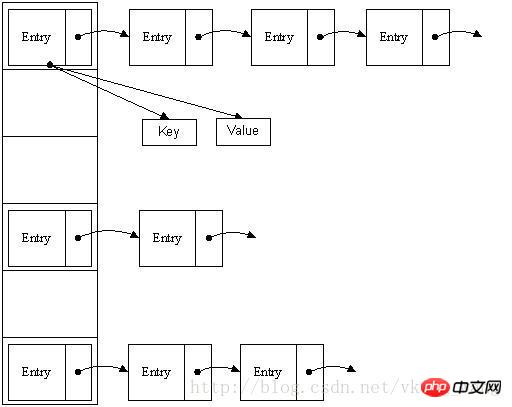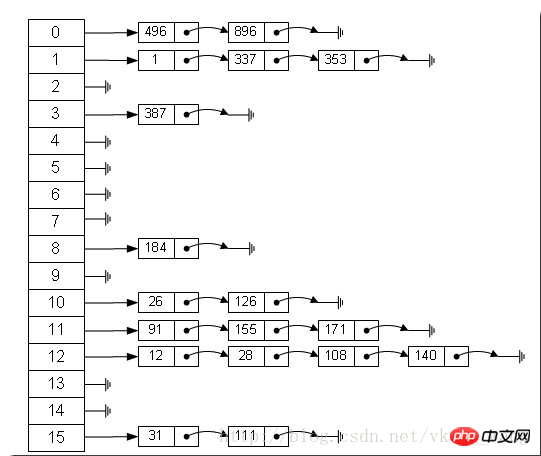這篇文章主要介紹了java 中HashMap實現原理深入理解的相關資料,需要的朋友可以參考下
1. HashMap的資料結構
資料結構中有數組和鍊錶來實現對資料的存儲,但這兩者基本上是兩個極端。
陣列
陣列儲存區間是連續的,佔用記憶體嚴重,故空間複雜的很大。但數組的二分查找時間複雜度小,為O(1);數組的特徵是:尋址容易,插入和刪除困難;
鍊錶
鍊錶儲存區間離散,佔用記憶體比較寬鬆,故空間複雜度很小,但時間複雜度很大,達O(N)。 鍊錶的特點是:尋址困難,插入和刪除容易。
哈希表
那我們能不能綜合兩者的特性,做出一種尋址容易,插入刪除也容易的資料結構?答案是肯定的,這就是我們要提起的哈希表。哈希表((Hash table)既滿足了資料的查找方便,同時不佔用太多的內容空間,使用也十分方便。
哈希表有多種不同的實作方法,我接下來解釋的是最常用的方法- 拉鍊法,我們可以理解為「鍊錶的陣列」 ,如圖:


數組+鍊錶組成的,一個長度為16的數組中,每個元素存儲的是一個鍊錶的頭結點。例如上述哈希表中,12%16=12,28%16=12,108%16=12,140%16=12。 ## HashMap其實也是一個線性的數組實現的,所以可以理解為其存儲資料的容器就是一個線性數組 這裡。 HashMap有做一些處理。 ,從屬性key,value我們就能很明顯的看出來Entry就是HashMap鍵值對實現的一個基礎bean,我們上面說到HashMap的基礎就是一個線性數組,這個數組就是Entry[],Map裡面的內容都保存在Entry[]裡面。演算法,大致是這樣實作:
/**
* The table, resized as necessary. Length MUST Always be a power of two.
*/
transient Entry[] table;1)put
#疑問:如果兩個key透過hash%Entry[].length得到的index相同,會不會有覆蓋的危險? 這裡HashMap裡面用到鍊式資料結構的一個概念。上面我們提到Entry類別裡面有一個next屬性,作用是指向下一個Entry。打個比方, 第一個鍵值對A進來,透過計算其key的hash得到的index=0,記做:Entry[0] = A。一會後又進來一個鍵值對B,透過計算其index也等於0,現在怎麼辦? HashMap會這樣做:B.next = A,Entry[0] = B,如果又進來C,index也等於0,那麼C.next = B
,Entry[0] = C;這樣我們發現index=0的地方其實訪問了A,B,C三個鍵值對,他們透過next這個屬性連結在一起。所以疑問不用擔心。也就是說數組中儲存的是最後插入的元素。 到這裡為止,HashMap的大致實現,我們應該已經清楚了。
// 存储时: int hash = key.hashCode(); // 这个hashCode方法这里不详述,只要理解每个key的hash是一个固定的int值 int index = hash % Entry[].length; Entry[index] = value; // 取值时: int hash = key.hashCode(); int index = hash % Entry[].length; return Entry[index];
public V put(K key, V value) {
if (key == null)
return putForNullKey(value); //null总是放在数组的第一个链表中
int hash = hash(key.hashCode());
int i = indexFor(hash, table.length);
//遍历链表
for (Entry<K,V> e = table[i]; e != null; e = e.next) {
Object k;
//如果key在链表中已存在,则替换为新value
if (e.hash == hash && ((k = e.key) == key || key.equals(k))) {
V oldValue = e.value;
e.value = value;
e.recordAccess(this);
return oldValue;
}
}
modCount++;
addEntry(hash, key, value, i);
return null;
}2)get
void addEntry(int hash, K key, V value, int bucketIndex) {
Entry<K,V> e = table[bucketIndex];
table[bucketIndex] = new Entry<K,V>(hash, key, value, e);//参数e, 是Entry.next
//如果size超过threshold,则扩充table大小。再散列
if (size++ >= threshold)
resize(2 * table.length);
}3)null key的存取
null key總是存放在Entry[]數組的第一個元素。
public V get(Object key) {
if (key == null)
return getForNullKey();
int hash = hash(key.hashCode());
//先定位到数组元素,再遍历该元素处的链表
for (Entry<K,V> e = table[indexFor(hash, table.length)];
e != null;
e = e.next) {
Object k;
if (e.hash == hash && ((k = e.key) == key || key.equals(k)))
return e.value;
}
return null;
} private V putForNullKey(V value) {
for (Entry<K,V> e = table[0]; e != null; e = e.next) {
if (e.key == null) {
V oldValue = e.value;
e.value = value;
e.recordAccess(this);
return oldValue;
}
}
modCount++;
addEntry(0, null, value, 0);
return null;
}
private V getForNullKey() {
for (Entry<K,V> e = table[0]; e != null; e = e.next) {
if (e.key == null)
return e.value;
}
return null;
}這表示陣列下標相同,並不表示hashCode相同。
5)table初始大小
public HashMap(int initialCapacity, float loadFactor) {
.....
// Find a power of 2 >= initialCapacity
int capacity = 1;
while (capacity < initialCapacity)
capacity <<= 1;
this.loadFactor = loadFactor;
threshold = (int)(capacity * loadFactor);
table = new Entry[capacity];
init();
}注意table初始大小并不是构造函数中的initialCapacity!!
而是 >= initialCapacity的2的n次幂!!!!
————为什么这么设计呢?——
3. 解决hash冲突的办法开放定址法(线性探测再散列,二次探测再散列,伪随机探测再散列) 再哈希法 链地址法 建立一个公共溢出区
Java中hashmap的解决办法就是采用的链地址法。
4. 再散列rehash过程
当哈希表的容量超过默认容量时,必须调整table的大小。当容量已经达到最大可能值时,那么该方法就将容量调整到Integer.MAX_VALUE返回,这时,需要创建一张新表,将原表的映射到新表中。
/**
* Rehashes the contents of this map into a new array with a
* larger capacity. This method is called automatically when the
* number of keys in this map reaches its threshold.
*
* If current capacity is MAXIMUM_CAPACITY, this method does not
* resize the map, but sets threshold to Integer.MAX_VALUE.
* This has the effect of preventing future calls.
*
* @param newCapacity the new capacity, MUST be a power of two;
* must be greater than current capacity unless current
* capacity is MAXIMUM_CAPACITY (in which case value
* is irrelevant).
*/
void resize(int newCapacity) {
Entry[] oldTable = table;
int oldCapacity = oldTable.length;
if (oldCapacity == MAXIMUM_CAPACITY) {
threshold = Integer.MAX_VALUE;
return;
}
Entry[] newTable = new Entry[newCapacity];
transfer(newTable);
table = newTable;
threshold = (int)(newCapacity * loadFactor);
}
/**
* Transfers all entries from current table to newTable.
*/
void transfer(Entry[] newTable) {
Entry[] src = table;
int newCapacity = newTable.length;
for (int j = 0; j < src.length; j++) {
Entry<K,V> e = src[j];
if (e != null) {
src[j] = null;
do {
Entry<K,V> next = e.next;
//重新计算index
int i = indexFor(e.hash, newCapacity);
e.next = newTable[i];
newTable[i] = e;
e = next;
} while (e != null);
}
}
}以上是深入理解java中HashMap的實作原理(圖)的詳細內容。更多資訊請關注PHP中文網其他相關文章!




